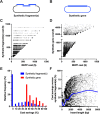Repository-based plasmid design
- PMID: 31917791
- PMCID: PMC6952187
- DOI: 10.1371/journal.pone.0223935
Repository-based plasmid design
Erratum in
-
Correction: Repository-based plasmid design.PLoS One. 2020 Feb 27;15(2):e0229981. doi: 10.1371/journal.pone.0229981. eCollection 2020. PLoS One. 2020. PMID: 32108829 Free PMC article.
Abstract
There was an explosion in the amount of commercially available DNA in sequence repositories over the last decade. The number of such plasmids increased from 12,000 to over 300,000 among three of the largest repositories: iGEM, Addgene, and DNASU. A challenge in biodesign remains how to use these and other repository-based sequences effectively, correctly, and seamlessly. This work describes an approach to plasmid design where a plasmid is specified as simply a DNA sequence or list of features. The proposed software then finds the most cost-effective combination of synthetic and PCR-prepared repository fragments to build the plasmid via Gibson assembly®. It finds existing DNA sequences in both user-specified and public DNA databases: iGEM, Addgene, and DNASU. Such a software application is introduced and characterized against all post-2005 iGEM composite parts and all Addgene vectors submitted in 2018 and found to reduce costs by 34% versus a purely synthetic plasmid design approach. The described software will improve current plasmid assembly workflows by shortening design times, improving build quality, and reducing costs.
Conflict of interest statement
J.T. is employed at and D.D. is a shareholder in Lattice Automation, Inc. which makes commercial software for biologists. This does not alter our adherence to PLOS ONE policies on sharing data and materials. All software and data affiliated with this publication is and will remain accessible and open-source.
Figures




References
-
- Lodish H, Berk A, Zipursky SL, Matsudaira P, Baltimore D, Darnell J. DNA Cloning with Plasmid Vectors. Mol Cell Biol 4th Ed. 2000. [cited 5 May 2019]. Available: https://www.ncbi.nlm.nih.gov/books/NBK21498/
MeSH terms
Substances
LinkOut - more resources
Full Text Sources

